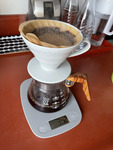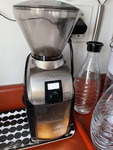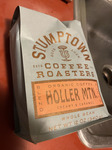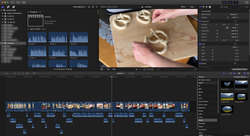 |
| Angelika/Mike Schilli |
|
Michael Because of Corona, we haven't gone out to eat at a restaurant for a whole year, but one luxury we allowed ourselves at home was good coffee. According to my research, in Germany, any average household owns a space age technolgy coffee machine costing more than a thousand Euros a piece. That's been standard for at least the last 20 years. If you don't have one, you're considered a poor wretch. It's different here in America: the trend is going back to the 60s, and to Grandma's coffee grinder and a porcelain filter attachment, trendily called "V60".
To grind whole roasted coffee beans, we bought the "Virtuoso+" model made by the coffee grinder company "Baratza", which has an Italian sounding name, but actually is American. This model grinds the coffee consistently every time, and won't keep grinding longer if you keep the button pressed, which is common with cheap products. The coffee production must be reliably reproducible, otherwise it's like playing the lottery! By the way, I was told by a trusted resource at my employer that an employee in the coffee kitchen was observed grinding coffee beans during his break with a hand grinder, just like Räuber Hotzenplotz's grandma, for a whopping 10 minutes. He must have written really elegant software afterwards!
Pouring the heated water from the kettle into the filter with the ground coffee is not trivial. In a Youtube video about the coffee filter attachment, British coffee expert James Hoffmann explains that for two cups, you first put 25g of coffee grinds in the filter, then pour 100g of water, then wait 20-40 seconds while constantly shaking the filter attachment until the coffee starts blooming, and finally pour the remaining 350g of water while swirling. You read that right, coffee snobs put the pot with the filter attachment on a digital scale and measure the exact amount of water.
Regarding the beans: For decades we had been drinking imported Dallmayr Prodomo because it was gentle with both of our stomachs and still tasted good. We can no longer tolerate darker roasts, sold in America as "French Roast," but those aren't even popular here anymore. They were for a while, shortly after Starbucks radically changed American coffee habits in an astonishing victory during the 1990s. It replaced the usual dishwater that was created by brewing a teaspoon of powder from the "Folgers" three-kilogram can and taking on a nice malty consistency after sitting on a hot plate for hours. Today, coffee snobs drink milder, lightly roasted varieties, recognizable by lighter beans, but still tickling all taste buds.
Following recommendations from colleagues at work, I ordered coffee beans online from luxury roasters like Little Owl Coffee in Denver or Verve Coffee, a hipster company in San Francisco. The problem with luxury coffee is that you quickly get used to better quality and suddenly regular coffee tastes like slop from a trucker's gas station. But hey, you only live once, life's too short to drink substandard coffee!














